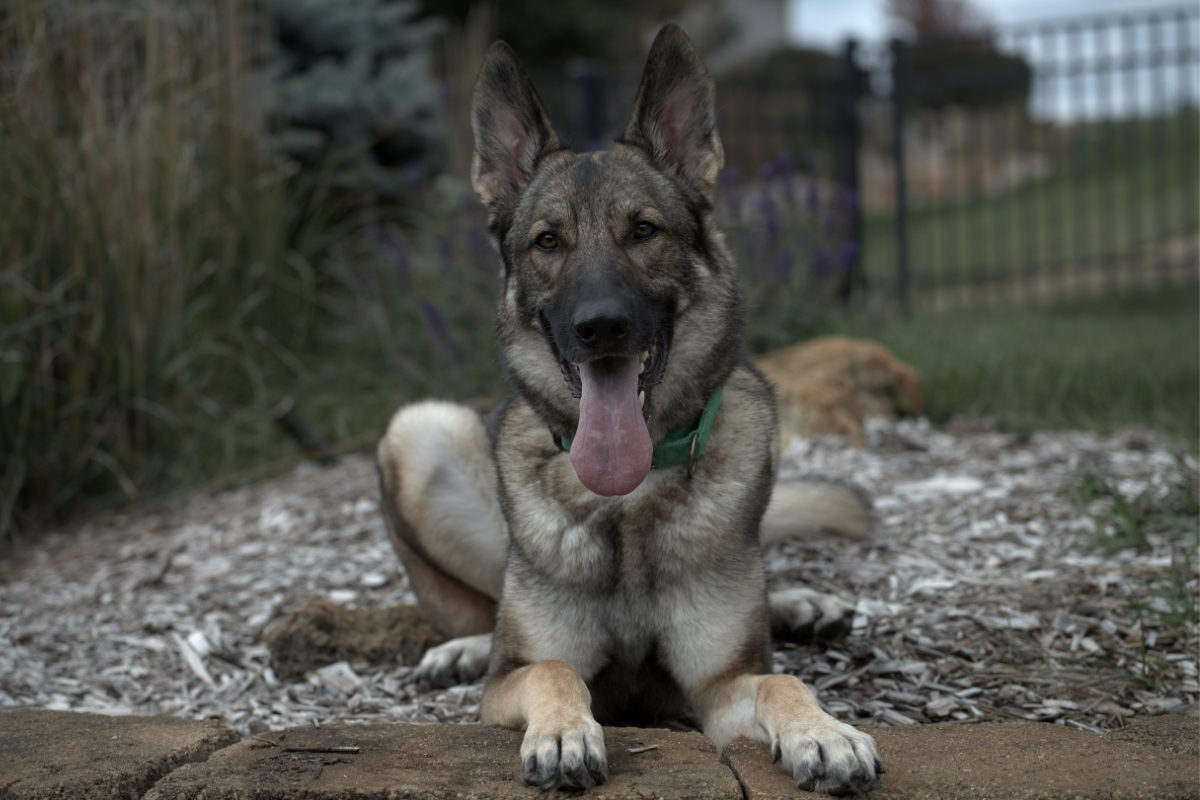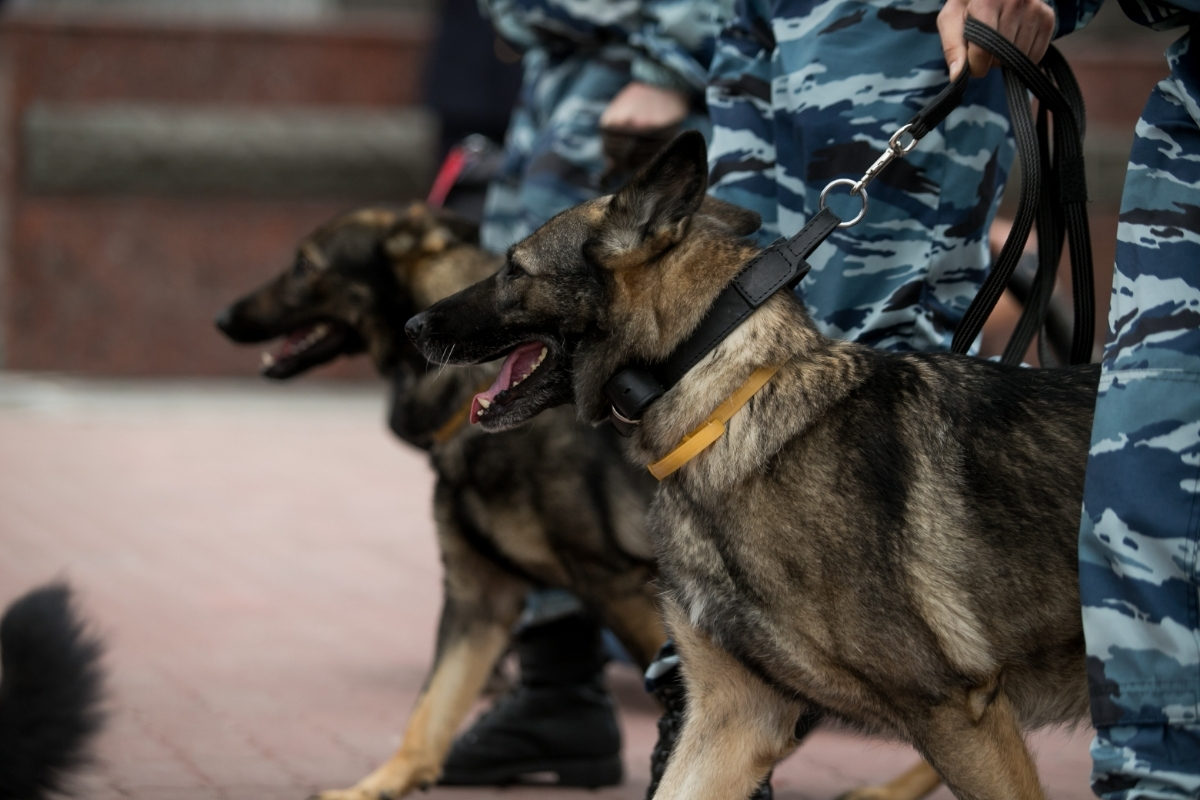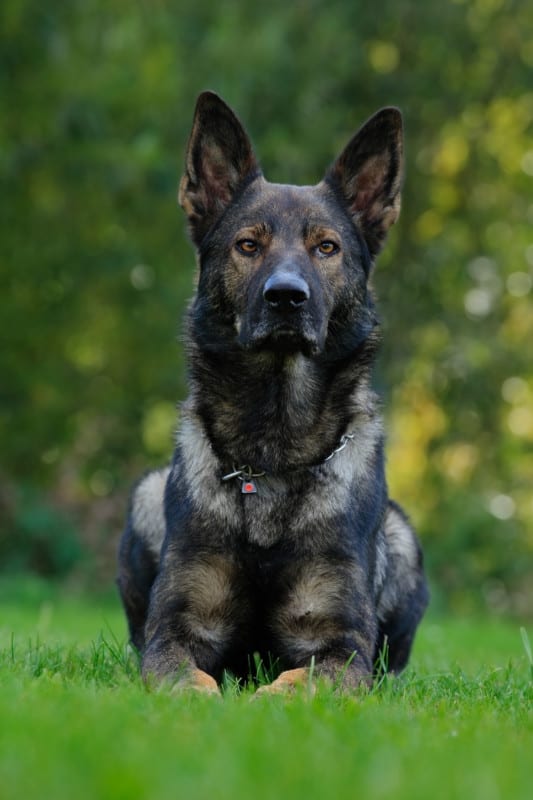If you’re interested in getting a hardworking dog, the name of German Shepherds might have popped up. But not all GSDs are built alike. With a more sloped back and shorter hind legs, show dog German Shepherds do not have the same work ethic as working line GSDs like the Czech German Shepherds.
Czech German Shepherd dogs have a strong work ethic, denser bone size, and a long lifespan. These dogs develop fewer health complications and aren’t considered aesthetic by dog show standards even though they have niche appeal and a strong desire to please and protect, making them perfect guards.
In this article, you will learn everything you need to know before getting a Czech GSD, including whether you should get one in the first place. You’ll know more about their working drive, training, and care of Czech Shepherds so you can make a sound decision and know exactly what to do if you get the dog.

But first, here’s a glance at the breed…
| Czech German Shepherd | Breed Characteristics |
|---|---|
| AKC Group | Herding |
| Origin | Czechoslovakia |
| Type | Working / Companion |
| Other Names | Czech Shepherd Czech Alsation |
| Breed Size | Medium-Large |
| Height | 24-26 inches (Males) 22-24 inches (Females) |
| Weight | 66-88 pounds (Males) 49-71 pounds (Females) |
| Temperament | Brave, Protective, Watch-dog, Strong, Confident, Intelligent, Alert, Independent, Loyal, High-energy, Aloof, Affectionate, Adaptable, Territorial |
| Appearance | Muscular, Erect Ears, Large head, Strong jaws, Straighter Back, Athletic, Agile |
| Lifespan | 12-13 years |
| Health Issues | Hip Dysplasia, GDV (bloat), Sensitive Stomach |
| Coat Colors | Sable, Black & Sable, Black |
| Coat Type | Double-coated, Short-Medium, Medium |
| Shedding | Heavy |
| Grooming | Moderate |
| Easy to Train | Yes |
| Exercise Needs | Medium-High |
| Hypoallergenic | No |
| Child Friendly | Yes |
| Pet Friendly | Yes |
| Good for new owners | Yes |
| Cost | $1000 – $4000 |
Origin and History
What is a Czech German Shepherd?
The term Czech Shepherd and Czech German Shepherd refers to a specific line of GSDs. This shouldn’t be confused with any German Shepherd born in the Czech Republic.
Dog breed names have countries or regions incorporated based on where they originated, not where the specific dog was born, which is why you can have an American GSD born in The Czech Republic and a Czech one born in the US. This brings us to the breed’s origin as its defining factor.
Czech German Shepherds are working line German Shepherds first bred in Czechoslovakia in 1955 under the Czech Alsatian breeding program. Unlike the traditional German Shepherds who were bred for herding sheep and then adapted to police work, the Czech German Shepherd was bred for law enforcement.
Remember, the name German Shepherd isn’t the only breed title and wasn’t used as frequently back then as it is now. Alsatian, also an equally valid name, was used more prominently outside Germany and was adopted by the Czech military’s breeding program.
Even today, a Czech German Shepherd can be called a Czech Alsatian, which sounds less contradictory. Below are the three ways you can refer to the dog:
- Czech German Shepherd – Think of the term as similar to “American French Fries,” which would be technically accurate for an American spin on the dish but sounds contradictory.
- Czech Shepherd – A valid way to refer to the breed but not technically accurate. While having similar nomenclature (area of origin + shepherd), the Czech GSDs were not bred to be shepherds. Going by the same conventions, it would be more accurate to call them Czech patrol dogs.
- The Czech Alsatian – The most accurate way to refer to a Czech German Shepherd given that the term German Shepherd and Alsatian are interchangeable, and using Alsatian removes the Czech-German contradiction. More importantly, it pays homage to the Czech Alsatian breeding program, where this line was first perfected.
The Czech Alsatian breeding program was meant to, among other things, aid Pohranicni Straze, The Czech army’s border control force. This might drum up images of dogs being unleashed on humans, which leads to the incorrect conclusion that these dogs were bred for aggression. However, there’s no documentation of Czech GSDs being used this way.
Czech German Shepherds were bred for high stamina, strong work ethic, and the ability to follow orders. The latter of these has to do with working intelligence, which is quite high among this line of GSDs. Their aggression and friendliness are both mild, and they can be trained to be offensive or passive, making them acceptable family dogs.
Watch This Gorgeous 7-Month-Old Sable Czech GSD…
Czech German Shepherd vs. East German Shepherd (DDR)
Czech German Shepherds and East German Shepherds were bred from the same line for similar tasks in neighboring regions belonging to the same block. However, they’re not the same dog.
Czech German Shepherds are slightly bulkier than East German Shepherds. Moreover, they come in a larger variety of shades than East GSDs, who are comparatively darker than the Czech German Shepherds.
Check out this interesting Czech & DDR Bloodline Chart by Von Ultimate Kennels.
Appearance and Size
How Big Do Czech German Shepherds Get?
Its dark color, hard-to-spot eyes, and hulking physique can give potential intruders a much-needed pause. Czech German Shepherds may not have the same intimidating size as a King Shepherd but staying purer to the German Shepherd line, this is one of the biggest GSDs out there.
Czech German Shepherds have a shoulder height of 24 to 26 inches for males and 22 to 24 inches for females. Males will weigh 66-88 lbs and females 49-71 lbs. The double coat and heavy muscle mass of Czech German Shepherds, alongside their genetics, are key contributors to the breed’s size.
However, if one’s looking for height alongside German Shepherd features, a better alternative would be the King Shepherd. The Czech German Shepherd is comparatively more lucrative only if you want a combination of height alongside a superior work ethic.
Czech German Shepherd Colors
Czech German Shepherds come in sable, black, or a mix of the two colors. The black look is less prominent than sable, and the dog doesn’t come in as expansive a range of colors as its traditional counterpart, the German Shepherd, mainly because Czech GSDs were bred for work and not looks.
Ironically, that didn’t stop people from getting fascinated by the dog’s looks anyway. Among the key visual aspects admired by people who adopt Czech German Shepherds is the dog’s sheer physique. This brings us to the breed’s temperament.
Temperament
Guarding, Protection, and Working Drive
Czech German Shepherds are easier to train to guard because protective instincts are natural to the breed. Still, you must make room for special guard training, mainly because the dog will need to learn to differentiate between actual threats and perceived threats.
Untrained dogs on both sides of the spectrum can fail to be good guards. Ones with naturally low protective instincts are so social they might as well give the intruders a gift hamper upon breaking and entering.
Thankfully, this isn’t the case with Czech German Shepherds or any German Shepherd. However, GSDs, including Czechs, can lean towards the other extreme.
Czech German Shepherds might be so protective that they might try to protect you from your own friends and other visitors.
That’s why, during the early stages of your dog’s development, you’ll need to train him to understand guard commands, including ones that lower their reaction, get them silent, and bring them to heel.
Given that you do this work, you’ll be rewarded proportionally because the Czech German Shepherd’s work ethic is admirable. You’ll have a valuable guard you can rely on, be it for your home or business.
These dogs are eager to please and loyal, which alongside their stamina, results in machine-like effectiveness.
A Czech German Shepherd’s productivity can also lead to pain. Because they can have robotic effectiveness in guarding, fetching, and staying “on duty,” some people find it easy not to have empathy for them.
If you’re adopting a fully grown Czech German Shepherd from a shelter, keep the above information regarding temperament in mind and add to that the fact that your dog is likely love-starved. Be more affectionate and make sure the dog is not overworked.
Types of Work Suited to Czech Shepherds
Czech German Shepherds can do every type of work done by standard working line German Shepherds except with more vigor and, often, with higher capacity. This higher work capacity has to do with their denser bones and bulkier muscles.
More specifically, Czech German Shepherds can be used as aides to personal guards, can carry tactical gear on treks, have the capacity to be trained for search and rescue, and can be taught to hunt on command. While their initial military use didn’t involve “sniff and sort” tasks, they do have the instinct and ability to pull these off.

Here is how the types of work will likely vary for Czech GSDs:
- Aide to personal guards – Compared to traditional German Shepherds, there’s little difference in how good of a companion to stationary guards these dogs can be. However, for mobile security, military, and police, the stamina difference means Czech German Shepherds can go longer than other breeds.
- Carrying tactical gear – A rescue group and military utility function, carrying tactical gear has been added to the things dogs can do relatively recently. Czech GSDs can do this better than most breeds of GSDs, including East German Shepherds.
- Search and Rescue – Many intelligent canine breeds are used for search and rescue missions. Czech German Shepherds can be trained to perform these functions with similar effectiveness as most working line German Shepherds are better than any show line variety.
- Hunting – Czech German Shepherds can hunt bigger prizes than traditional German Shepherds, mainly because of better tracking senses. However, a Czech German Shepherd must be trained to pick up on trails at an early age. The longer a Czech GSD is left untrained, the harder he is to train as a hunter. For more info on tracking, check out my full guide, How to Train a German Shepherd to Find Things.
- Sniff and sort – Czech GSDs are intelligent and can learn to sniff and sort substances. Each dog can be trained to bark upon noticing hints of a specific substance. Usually, these are controlled substances. Standard working line GSDs have pretty much the same potential for sniffing and sorting substances between “okay” (don’t bark) and “not okay” (bark) categories and can be used at airports, complex entries, and gates.
“As someone from a law enforcement background, I’ve seen many times, sniffer dogs indicate a “find” and it’s amazing to watch.“
World of Dogz
Are Czech German Shepherds Good Family Dogs?
Because these dogs have a great work ethic, they’re often used in more formal institutionalized settings. As a result, there might be a myth prevalent regarding their compatibility with households.
Czech German Shepherds are good family dogs if they are raised in a home environment. Their protectiveness and ability to be loyal to more than one individual allows them to guard the whole family. Moreover, their desire to work and please can result in lots of active playtime for the kids.
Czech GSDs are the dog of choice for those looking for a dog that looks intimidating but can assimilate into a family.
Adopting such a dog at a young age is the safest option, as adult dogs might have been trained differently. Some Czech German Shepherds can be awkward in a family setting. They also need a large backyard to expend their energy. This combination can make them unfit for families.
You should get a Czech GSD as your family dog if you’re willing to raise one from 8-weeks old and have a home large enough for a big dog. If your family resides in an enclosed flat or apartment of any kind, a Czech German Shepherd is not the best fit, and getting one for cosmetic appeal can be cruel and ultimately very frustrating.
How to Care for a Czech German Shepherd
Training and Exercise
Czech German Shepherds have greater mass and higher energy than other working lines. As a result, one might assume that they need more exercise than the average German Shepherd. This is not true.
Czech German Shepherds need between one to two hours of exercise a day, like other varieties. Their greater bone mass cancels out higher energy during regular exercise. In other words, a Czech GSD expends more energy per minute than a lighter, smaller German Shepherd.
Best exercises for a Czech GSD:
Czech Alsatians have the stamina to be reckoned with, which means they can have reserves of energy that need to be spent well after you’ve exhausted yours. That’s why the best exercises for your Alsatian are ones that are efficient and do not exhaust you while ensuring that your GSD uses up his energy. Here are some of these exercises.
- Fetch – You stand (or sit) in the same spot while your dog runs a significant area to get the frisbee, stick, or toy you throw at a distance. You can also get the iFetch Interactive Ball Launcher from Amazon for an even easier life.
- Off-lead running – This exercise involves your dog running free in an open space with a secure boundary (usually a backyard or enclosed field). Make sure there are no strangers or small animals around.
- Tricks – Getting your best friend to do tricks will mentally stimulate him and keep him engaged. You can do this with products like dog puzzle treat dispensers which also automate rewards alongside animal engagement. Start with something like the Outward Hound Dog Brick Interactive Treat Puzzle Toy from Amazon. I love this puzzle toy which has almost 50,000 top reviews.
To make sure your dog’s energy goes towards fulfilling his potential, you need to get intentional about his training. Right away, you need to establish yourself as a guardian of authority.
This happens when you get your dog as a puppy. By making him see you as a guide, you make more advanced training easy. Minimizing resistance by avoiding the urge to force also helps.
If you’ve previously owned a dog, the following comparison might help you understand how easy or difficult it is to train a Czech German Shepherd. Border Collies and Poodles are slightly more intelligent than Czech GSDs, whereas these German Shepherds have a much broader range of skills that can be trained to a greater degree of specialization.
“In other words, Czech GSDs might require a little more patience than their sans-same counterparts, but the extra time you put in is worth the effort.”
World of Dogz
It’s also worth noting that Czech GSDs are among the top intelligent dog breeds, as are German Shepherds as a whole. If you’ve ever had an experience with a Husky, Greyhound, or Bullmastiff, training your doggo will be a cakewalk.
Coat and Grooming
Czech German Shepherds shed a lot, and I mean a lot, mainly from their undercoat, which is soft and fluffy.
This means you’ll need to brush and groom your dog on a regular basis so you don’t have to deal with the mess from scattered shedding. Even after brushing, significant amounts of fur will find its way onto every coarse or fabric surface the dog rubs against.
Not only do you have to contend with daily shedding, but also seasonal shedding. This is when they “blow their coat” in the Spring and Fall, ready for the change of season ahead.
So, before you get yourself a Czech German Shepherd, you must commit to managing the mess that comes with owning one. If you do not manage the double-layered coat, your dog might overheat unless you live in a region where pool season lasts a week!
PRO TIP! Find out the grooming tools I use on my German Shepherd here, Best Grooming Tools for German Shepherds: Only These Make the Cut!
While Czech GSDs are not like Siberian Huskies in that they don’t have to live in a polar ambiance with snow around, they are dogs originating from a snowy region. Managing your Czech German Shepherd’s fur involves brushing its coat every day or every other day.
Doing this less frequently will lead to more time vacuuming. The grooming routine also includes bathing them 2-3 times a year.
Health Issues
Since all GSDs are prone to some health problems, it is best to contextualize the Czech Shepherd’s health risks by comparing them to those of East German Shepherds.
In terms of health, neither breed is too prone to early-onset health problems, mainly because both were bred for hard work. Developing a breed that would get incapacitated due to health problems wouldn’t be feasible. Still, this doesn’t mean that Czech GSDs or East GSDs don’t have health problems.
Czech German Shepherds can have eye problems, may suffer from bloating (GDV), and develop ear infections. And like most GSDs, they, too, are at risk of hip dysplasia.
On the other hand, East German Shepherds are less susceptible to hip dysplasia but share the risk of developing allergies, getting bloated, and suffering from infections.
Do you want to learn more about GSD care? Check out this article, How To Care for a German Shepherd.
Today’s Czech German Shepherds
Where to Buy or Adopt
Czech German Shepherds are a niche interest variety of the breed with similar levels of popularity as East German Shepherds. Since these dogs are bred from similar bloodlines, you can find specialized breeders who offer working-line German Shepherds.
Some breeders also market themselves solely around the Czech name. Usually, they hail from the Czech Republic, which adds a sense of connection to the breed’s origin.

However, the breeder’s ethnicity or country of origin is nowhere close to being as important as the breeder is reputable. That’s why, when you’re looking to get a Czech German Shepherd from a breeder, you must look for the following:
- State and federally compliant licensing – This is essential to make sure you’re not facilitating an illegal business by overlooking the required licensing and permits. Different states have different regulations, including some breed-specific ones.
- A permanent address, preferably printed on the business collaterals – Licenses and permits can be faked. If you get your dog from a breeder, make sure you’re not getting an unhealthy poorly-handled one from a puppy mill. One sign of irresponsible breeders is a six-week release, but an even greater sign is the lack of a printed permanent address on brochures, flyers, or signage.
- Sufficient lineage know-how and introduction to parents – While the above precautions ensure you get your dog from a reputable breeder, this one makes sure you get the right breed. Ask the breeder to see the parents so you can confirm that what you’re taking home is a Czech German Shepherd and not a dark German Shepherd or even another breed.
Moving away from purchasing best practices, let’s look at adoption options. Since Czech GSDs are working line GSDs, you might be able to get a well-disciplined, well-trained dog at retirement age. If you don’t mind adopting a nine-year-old, then writing to your local police department might be an option.
Alternatively, you can search “Czech German Shepherd for adoption” on Google and find online listings. However, since traditional GSD adoption is more likely, given the breeding and availability statistics, you might have a harder time finding the Czech variety.
How Much Does a Czech German Shepherd Cost?
Czech German Shepherds are more productive than standard types, leading some to the assumption that they may be more expensive. This misconception stems from human resource economics where the most work-valuable individual is usually compensated the highest. In reality, Czech GSDs aren’t much different from the standard variety.
Czech German Shepherd puppies cost between $1000 – $4000, with an average price of $2000. Factors influencing price include supply and demand, breeder qualifications, bloodline, location, litter size, registration costs, health screening, vaccinations, microchipping, and vet fees.
To learn how I obtained these figures, you can check out my research in this article, How Much is a German Shepherd? 21 Examples!
To make sure you’re getting the right price, follow these best practices.
- Inquire about stud variety – The studs used also impact the price as much as the cost of doing business. That’s why learning about the stud used in your Czech GSD’s conception is crucial to making a case for the price.
- Get your dog from a mildly crowded shelter – You do not want to get an unreasonable priced dog that might result from unusually high demand in a specific region. If your city happens to be going through a celebrity dog craze, you might find Czech GSDs barely available. If the shelter is overcrowded, the dog might be sold cheap.
Is a Czech German Shepherd Right For You?
Czech Shepherds are for you if you do not care too much about your dog matching the traditional standards of German Shepherd beauty and instead want an athletic dog with better stamina. Here are the pros and cons of having this breed.
Pros:
- More muscular and denser boned than traditional German Shepherds, better equipped to work.
- Stronger desire to please, eager to help, play and be engaged.
- Fewer health complications.
Cons:
- Few colors to choose from, dark and sable variety only.
- Aesthetic appeal isn’t broad. Not everyone will find your dog beautiful.
- Poor training can lead to a dog that’s difficult to control.
FAQs
How Long Do Czech German Shepherds Live?
Czech German Shepherds can live 12-13 years if they are healthy and reside in the right environment. However, factors like genetics and health issues can reduce lifespan. But, as they were initially bred for military use, they peak at around 9 years old and usually have a long retirement.
Why Are German Shepherds Called Czech?
German Shepherds are called Czech if they belong to the working line breed developed in Soviet Czechoslovakia, a region neighboring East Germany where a similar breed was developed for similar military use (DDR Shepherd). Czech GSDs are also referred to as Czech Shepherds or Czech Alsations.
Related Posts You May Like:





